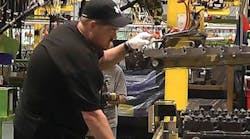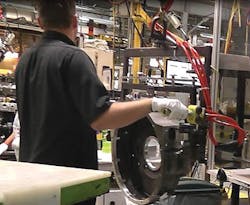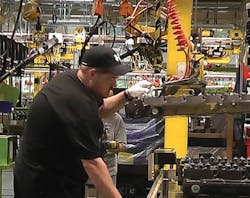Electric cranes and hoists are ubiquitous (see Photos), but the NEC considers them to be “special equipment.” Though Art. 610 says it covers cranes, monorail hoists, hoists, and runways [610.1], it doesn’t define them in 610.2 (nor does Art. 100 define them).
Article 610 provides only one definition (festoon cable). Fortunately, Part II provides enough information about runways that you don’t need a separate definition of those. But nowhere does the NEC define the other 610.1 terms, so we’ve provided a little help on this front in the sidebar Crane vs. Hoist, and What’s a Runway?
The informational note under 610.1 refers you to ANSI B30, with the assumption being that you’re performing the installation per that and any other applicable standards.
After the scope and definition, Art. 610, Part I concludes with location-specific requirements [610.3]. If the crane or hoist operates:
• In a hazardous location, comply with the relevant Chapter 5 Articles (501, 502, 503).
• Over readily combustible material, locate its resistors inside a noncombustible enclosure.
• In working zones of electrolytic cells, insulate its conductive surfaces from ground.
Wiring
You can use conductors that are Type AC (with insulated grounding conductor), Type MC, or Type MI cable. All other conductors must be in raceway [610.11], except:
• Contact conductors [610.11(A)].
• Short lengths of exposed conductors at equipment (e.g., resistors) [610.11(b)].
• Flexible connections (e.g., to motors) [610.11(C)].
• Push-button station multi-cable [610.11(D)].
• Where flexibility is required for moving parts (use listed festoon cable or suitable cord) [610.11(E)].
You can use a common-return conductor for a crane or hoist operated by more than one motor [610.15].
Load calculations
Before you can size your conductors and overcurrent protection devices (OCPDs), you must determine the load size. If the load is:
• A single motor, use 100% of the motor nameplate full-load ampere rating [610.14(E)(1)].
• Multiple motors on a single crane or hoist. Add the motor nameplate full-load ampere rating of the largest motor to 50% of the motor nameplate full-load ampere rating of the next largest motor (or group of motors) [610.14(E)(2)].
• Multiple cranes or hoists on a common conductor system. Calculate the load for each crane, add them together, and then multiply the sum by the appropriate demand factor from Table 610.14(E).
Ampacity
Cranes and hoists are high torque loads, so the conductors can heat up fast. Consequently, the conductors have their own ampacity table: Table 610.14(A). Restrictions that apply to general conductor tables (310.15 tables) apply here. For example, you can use the 90° column only if all terminations used in the 90° environment are listed for 90°.
Some differences between these tables:
• Table 610.14(A) doesn’t have a 60° column.
• The range of conductor sizes in Table 610.14(A) is much smaller.
• Table 610.14(A) includes odd-numbered AWG sizes.
And perhaps most importantly, time is an ampacity factor in Table 610.14(A).
For example, a 1/0 conductor in Table 610.14(A) has a 30-min ampacity of 233A in the 75° column. This is close to the Table 310.15(B)(17) value of 230A. But at 60 min, the ampacity drops to 190A, which is close to the 60° column value (195A) in Table 310.15(B)(17). When you have multiple motors on a single crane or hoist, you must use the time column that applies to the longest time motor [610.14(E)(2)].
If the secondary resistor is separate from the controller, you must apply the appropriate conductor rating factor from Table 610.14(B).
Even if the table ampacity is sufficient for a given conductor size, you may have to use a larger conductor for the contact wires [610.14(D)]. These must comply with Table 610.14(D), which means the conductor will be 6 AWG, 4 AWG, or 2 AWG, depending upon the distance between supports. These conductors must comply with other rules too, as we shall see next.
Contact conductors
Part III of Art. 610 is all about contact conductors. The primary goal is to keep the conductors away from other possible current paths, including people. To meet that goal, you must:
• Locate and guard bridge contact conductors in a manner that prevents people from inadvertently touching energized current-carrying parts [610.21(A)].
• Guard runway conductors to prevent mechanical damage [610.21(A)].
• Use supports and strain insulators to ensure contact conductors can’t come within 1.5 in. of the surfaces they travel over [610.21(B)].
• Use insulating supports at intervals of 20 ft or less [610.21(C)].
• Keep bridge wire contact conductors at least 2.5 in. apart and use insulated saddles for spans exceeding 50 ft [610.21(D)].
Mechanically join all sections of contact conductors to provide a continuous electrical connection [610.21(G)]. Don’t use these conductors for any loads other than the cranes or hoists they serve [610.21(H)]. Collectors must be designed to minimize sparking between them and the contact conductor [610.22].
If you’re using rigid conductors, you must calculate the maximum support interval [610.21(E)]. That interval is 80 times the vertical dimension of the conductor, up to an absolute maximum of 15 ft. Space the conductors far enough apart to provide a clear separation of at least 1 in. from each other or from adjacent collectors.
You can use the track as a circuit conductor for one phase of a 3-phase supply to a carrier, crane, or trolley, if all of the following are true [610.21(F)]:
1. The conductors for the other two phases are insulated.
2. The supply is an insulating transformer.
3. Voltage doesn’t exceed 300V.
4. The rail serving as the conductor is bonded to the equipment bonding conductor at the transformer.
Disconnects
The 2014 NEC added a new provision for the disconnects. Whether for a crane runway, crane, or monorail hoist, the disconnect must be lockable in the open position [610.31(2) and 610.32]. Carrying over requirements from the 2011 NEC, these disconnects must comply with 430.109.
Install a disconnect between the runway contact conductors and the power supply [610.31]. It must:
• Be readily accessible and operable from the ground or floor level.
• Open all conductors simultaneously,
• Be within view of the runway contact conductors (unless for electrolytic cells).
Install a disconnect in the leads from the power supply to cranes and monorail hoists [610.32]. You can omit this disconnect if there’s no fixed work platform provided for servicing the unit and the unit is:
1. Controlled from the ground or floor level, and
2. Within view of the power supply disconnecting means.
Overcurrent protection
You have to size the branch circuit OCPDs before you can size the feeder OCPDs; you will see why, momentarily.
Part V presents the requirements for feeder conductors and OCPDs [610.41], branch-circuit OCPDs [610.42], and motor overload protective devices (ODPs) [610.43]. It’s helpful that this sequence follows a logical workflow.
Protect each branch circuit with fuses or inverse time breakers; use the rating indicated by Table 430.52. Where two or more motors operate a single motion, add up their total nameplate ratings and use that sum as the rating [610.42(A)].
Now, size your feeder OCPD [610.41(A)]. To do this:
1. Sum up all loads other than the largest rating or setting branch OCPD.
2. Add in the largest rating or setting branch OCPD.
3. Apply the demand factors from Table 610.14(E).
The NEC isn’t clear whether step 2 or step 3 comes first. To divine the intent, we look at Art. 430 requirements and use the same logic.
If multiple feeders supply a crane, repeat the above process for each one [610.41(B)].
Taps, overloads, and controllers
Let’s cover some odds ‘n’ ends. Taps must be one-third the conductor size [610.42(B)]. Motor overloads aren’t strictly required; you can count the branch OCPD as providing this protection [610.43(A)(1)].
Each motor must have its own controller [610.51], unless:
• It’s part of a group driving a single motion.
• The controller can switch between motors.
Grounding
Though the heading of Part VII refers to “grounding” the text of it accurately reflects Art. 100 definitions by requiring you to bond metallic surfaces.
Crane caveats
Cranes and hoists are special case motor loads, and Art. 610 has numerous caveats for installers. For example, the conductors have their own ampacity table, which, unlike those in Art. 310, are time-based. You must understand the application and conditions to do the job correctly.
Lamendola is an electrical consultant based in Merriam, Kan. He can be reached at [email protected].
SIDEBAR: Crane vs. Hoist, and What’s a Runway?
Cranes and hoists can both lift loads, but a hoist can lift a load vertically only. A crane can also move a load horizontally; it may even move the load anywhere on an X, Y, and Z grid). The “runway” [610.1] is to a crane what a track is to a train.
Cranes and hoists come in all sizes — from small, pendant-controlled units to cabin-sized systems that require a certified operator.






